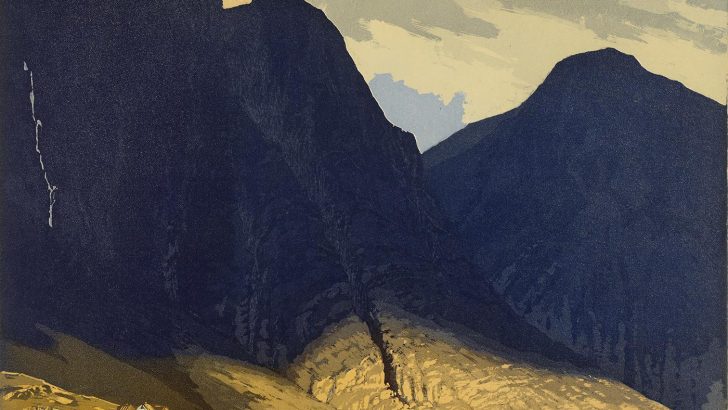Making their Mark: Irish Painter-Etchers 1880-1930
an exhibition curated by Anne Hodge (NGI) and Dr Angela Griffith (TCD)
National Gallery of Ireland, Merrion Square, Dublin – runs to 30 June 2019. Admission free.
A current exhibition at the NGI explores an almost forgotten aspect of modern Irish art, the activities of a small but influential and very talented group of etchers of Irish origin over the decades of the late Victorian era and the first decades of the 20th Century. Going beyond the resources of the NGI, items have been drawn from other collections, notably the British Museum and Trinity College.
The show is, in a way, dominated by a set of aquatints by Edward L. Lawrence (1868-1940) of a Norwegian fjord which is very powerful indeed; beside it is an image of Gordale Scar, an iconic place, which must have been imaged by many of the artists of the romantic tendency in Britain. But for Dubliners there is also what must be a unique image: the bottle blowers in the ‘Glass House’ down in Ringsend.
These are very dramatic items, but on the whole etchers preferred, and their medium blossomed in, quieter undramatic images of little corners of city and country, and pensive well-lived in faces.
Standing out also are the etchings made by Estella Solomons, largely in the 1920s, which have been greatly admired since they were first published.
But here a long context is provided to her work by images from 17 Irish artists and some seven of their influential teachers or inspirers.
Of particular interest to some readers will be the very striking portrait of Fr William Delaney SJ, the president of University College in Joyce’s day, one of the most significant figures in the development of Irish third level education. I had never seen this before. It expresses very well the personality of an important and memorable man.
It was, it seems, the lucky creation of a chance request for him to pose for Strang at an influential demonstration and show of etching in 1910 arranged by Dermot O’Brien. O’Brien invited the Jesuit to sit for the artist, remarking that he was ‘a most pleasant man with a fine head for Strang’s work’.
Also remarkable are George Atkinson’s etching of the Shannon Scheme works, which make a contrast to Sean Keating’s more familiar and more extravagant paintings and drawings.
Indeed, an interest in this show is to see the work of well known painters such as Lavery, Roderick O’Connor, Walter Osborne and S. C. Harrison, who rarely worked in this medium.
But the real enjoyment in the show comes from the pastoral and picturesque images of another Ireland, one which so-called ‘progress’ has badly damaged.
I have always been surprised by the disdain in which etchings and engraving are held. For those of limited means they make an ideal entry into collecting in a small way, being comparitively cheap.
These are not mass produced images, for each one has to be worked, inked and pulled by hand. But somehow to the investing collector they are not seen as ‘real art’; the curators of the show suggests that this is the way it has been in Ireland since the 1890s.
(By the way, Estella Solomon’s image of McDaid’s is not the well-known literary pub, but rather Hugh McDaid’s place at 27 D’Olier Street, leading into that strange little world of second-hand dealers in Leinster Market, that became a pseudo-Tudor passage with the building of the Gas Company offices.)


 Peter Costello
Peter Costello Edward L. Lawrenson (1868-1940), Sognefjord, Norway, 1924 © The Trustees of the British Museum
Edward L. Lawrenson (1868-1940), Sognefjord, Norway, 1924 © The Trustees of the British Museum 